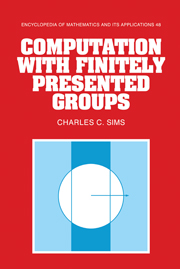Book contents
- Frontmatter
- Contents
- Preface
- Introduction
- 1 Basic concepts
- 2 Rewriting systems
- 3 Automata and rational languages
- 4 Subgroups of free products of cyclic groups
- 5 Coset enumeration
- 6 The Reidemeister-Schreier procedure
- 7 Generalized automata
- 8 Abelian groups
- 9 Polycyclic groups
- 10 Module bases
- 11 Quotient groups
- Appendix Implementation issues
- Bibliography
- Index
11 - Quotient groups
Published online by Cambridge University Press: 06 March 2010
- Frontmatter
- Contents
- Preface
- Introduction
- 1 Basic concepts
- 2 Rewriting systems
- 3 Automata and rational languages
- 4 Subgroups of free products of cyclic groups
- 5 Coset enumeration
- 6 The Reidemeister-Schreier procedure
- 7 Generalized automata
- 8 Abelian groups
- 9 Polycyclic groups
- 10 Module bases
- 11 Quotient groups
- Appendix Implementation issues
- Bibliography
- Index
Summary
We come now to the last of the major tools for studying a given finitely presented group G, the nilpotent quotient algorithm, the p-quotient algorithm, and the polycyclic quotient algorithm. Let e be a positive integer. Using the nilpotent quotient algorithm, we can determine the quotient G/γe+1(G), the largest nilpotent quotient of G having class at most e. For a given prime p, the p-quotient algorithm constructs the quotient G/φe+1(G), the largest quotient of G which is a p-group with exponent-p central class at most e. The polycyclic quotient algorithm lets us determine G/G(e)the largest solvable quotient of G having derived length at most e, provided G/G(e) is polycyclic. The quotients G/γe+1(G) and G/φe+1(G) are always polycyclic, but G/G(e) need not be. We can solve the word problem in G/G(e) if G/G(e − 1) is polycyclic, but we cannot in general work with subgroups of G/G(e) unless that group is polycyclic.
The definition of the term “nilpotent quotient algorithm” given here differs from the one used by most previous authors. Until recently, the only computer programs available for obtaining any nonabelian nilpotent quotients of a finitely presented group were implementations of the p-quotient algorithm, so this algorithm was frequently referred to as the nilpotent quotient algorithm. While it is certainly true that the p-quotient algorithm computes quotients which are nilpotent, it seems best to reserve the name “nilpotent quotient algorithm” for a procedure which determines the groups G/γe+1(G).
Describing quotient groups
This section explains the general approach used in the quotient algorithms discussed in this chapter.
Information
- Type
- Chapter
- Information
- Computation with Finitely Presented Groups , pp. 514 - 569Publisher: Cambridge University PressPrint publication year: 1994
